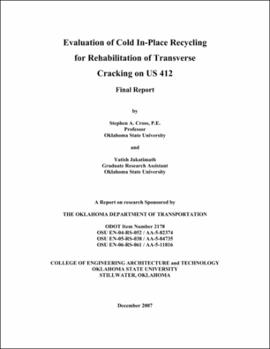| dc.creator | Cross, Stephen A. | |
| dc.creator | Jakatimath, Yatish | |
| dc.date.accessioned | 2018-04-20T22:47:19Z | |
| dc.date.available | 2018-04-20T22:47:19Z | |
| dc.date.issued | 2007-12 | |
| dc.identifier.govdoc | FHWA-OK-07-04 | |
| dc.identifier.other | Oklahoma Department of Transportation State Planning and Research item number 2178 | |
| dc.identifier.uri | https://hdl.handle.net/11244/299487 | |
| dc.description.abstract | Successful rehabilitation of transverse cracked hot mix asphalt (HMA) pavements has been a challenge for state DOTs. Conventional thin HMA overlays allow the rapid return of the existing transverse cracks and thicker HMA overlays are cost prohibitive. Cold In-Place Recycling (CIR) has been shown to be a cost-effective procedure for rehabilitation of transverse cracked HMA pavements. The use of fly ash Portland cement slurry to pretreat large transverse cracks has made CIR applicable to HMA pavements with severe (wide) transverse cracks. The new Mechanistic-Empirical Pavement Design Guide (MEPDG) uses dynamic modulus as a material characterization parameter for asphalt mixtures. In order to ensure CIR’s place in pavement maintenance and rehabilitation activities, guidelines on dynamic modulus (E*) parameters need to be developed. The objectives of this study were to evaluate the effectiveness of CIR with slurry crack injection to rehabilitate transverse cracked HMA pavements on two rehabilitation projects on US 412 in Beaver and Harper counties, to investigate the dynamic modulus properties of CIR mixtures, and to evaluate the appropriateness of the M-EPDG predictive equation for dynamic modulus for CIR mixtures. The CIR treatments have reduced the occurrence of transverse cracking but longitudinal wheel path cracking is occurring in the CIR test sections. The longitudinal cracking might be attributed to the thin, stiff HMA layer placed over the softer CIR layer. AASHTO TP 62 can be used to determine dynamic modulus of CIR mixtures with slight modification. The predictive dynamic modulus equations give good agreement with measured values at the three higher test temperatures if the aggregate properties are based on the RAP gradation and binder properties on the base binder in the asphalt emulsion. | |
| dc.format.extent | 87 pages | |
| dc.format.extent | 3,578,715 bytes | |
| dc.format.medium | application.pdf | |
| dc.language | en_US | |
| dc.relation.ispartofseries | No | |
| dc.relation.requires | Adobe Acrobat Reader | |
| dc.title | Evaluation of Cold In-Place Recycling for Rehabilitation of Transverse Cracking on US 412 (FHWA-OK-07-04 2178) | |
| dc.type | Technical Report | |
| dc.description.version | Final report | |
| dc.description.peerreview | No | |
| dc.type.material | text | |
| dc.subject.keywords | CIR | |
| dc.subject.keywords | dynamic modulus mechanistic pavement design | |
| dc.contributor.sponsor | Oklahoma Department of Transportation. Materials and Research Division. Office of Research & Implementation | |
